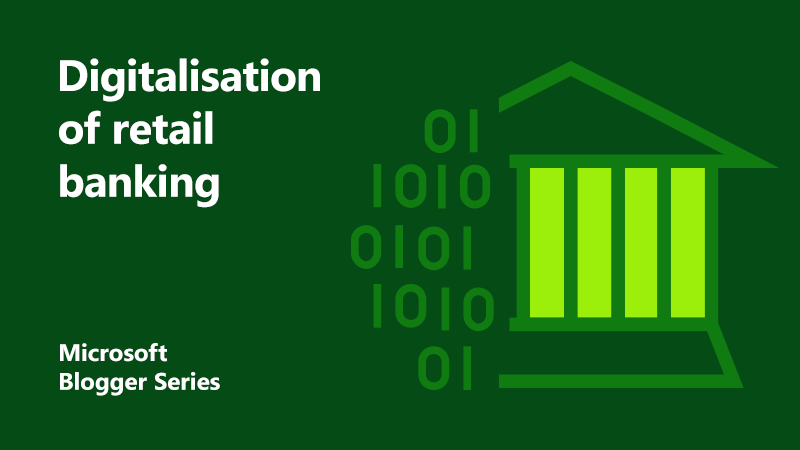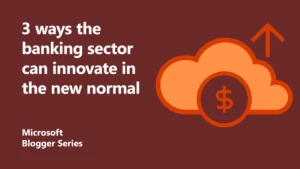
Why the digitalisation of retail banking matters
The digitalisation of retail banking has been one of the most vital, and long-overdue, initiatives in finance over the last decade. We’ve seen how truly important it is this year as customer demand shifted to more digital channels. In Micrsoft’s report, Boosting the innovation of banking business models, we look at how retail banks can succeed in the new normal. At Microsoft and the Financial Times, we firmly believe that now is the opportunity for banks to use new technology to improve customer service, pioneer new channels and products, cut costs and re-establish their social value with cynical customers.
Digital adoption has leapt forward two years in just a few months, both by choice and necessity. Bankers estimate there has been a sixfold surge in cashless transactions in 2020. Traditional lenders – with a cautious eye on fast-growing fintech startups – are each year investing tens of billions in innovation and upgrading their legacy systems. How can they ensure this money is wisely spent? And where and when will the sector start to see material return on investment (ROI)?
Innovation in digitalisation and ROI
 “There is no doubt COVID-19 has really changed and accelerated the pace of digital transformation,” said Craig Wellman, Head of UK Financial Services Sales at Microsoft during a joint webinar with the Financial Times on the topic.
“There is no doubt COVID-19 has really changed and accelerated the pace of digital transformation,” said Craig Wellman, Head of UK Financial Services Sales at Microsoft during a joint webinar with the Financial Times on the topic.
With the advent of cloud computing, he added that executives had already completely overhauled their ambitions. Their priorities are no longer only focused on cost cuts, but now also on AI-driven personalisation, cybersecurity and creating a faster, less cumbersome customer experience.
The normal ROI measures of customer loyalty, revenue generation and cost savings still remain relevant. Banks also have to invest to match to the high standards set by new consumer tech champions such as Amazon or Netflix.
“There’s no question customer expectations have changed a lot… their experience needs to feel personal, relevant and seamless,” said Josh Bottomley, Head of Digital at HSBC, Europe’s largest bank.
“The ‘computer says no’ example still sticks with people,” he added. “In banking there are still too many questions we can filter out from forms… We need to make it easier to log on to a single app with a personalised home screen.”
Digitalisation for competitive advantage
Banks are also challenged by easy-to-use fintech upstarts that are attracting droves of loyal users, especially among the young.
Lavanya Menon, Head of Digital Transformation Risk at Lloyds Bank, said that since her bank started its digitisation programme five years ago “we have made the gap between a fintech and a legacy bank smaller by trying to focus our investment on the ‘Amazonification’ of banking,” she said. “What has taken off is friction-free finance… that timeline is ever changing and never ending.”
Bottomley said another less obvious, but potentially more important, measure of return on digital investment was “future cost avoidance.”
He used the example of COVID-19. HSBC was able to participate in multiple government emergency financing schemes around the world in less than 48 hours by using secure, digital customer forms. This would have been impossible had the lender not migrated much of its data and processing to the cloud in recent years.
Long-term transformation and AI
 There must also be a balance between major long-term transformation and “quick wins” said Wellman. The latter “generate excitement among customers and at the board level with an easily visible and speedy ROI.”
There must also be a balance between major long-term transformation and “quick wins” said Wellman. The latter “generate excitement among customers and at the board level with an easily visible and speedy ROI.”
“You can’t just have a succession of unfinished five-year projects… When you get to the point previously thought to be a panacea, the market will have evolved again,” he added. For example, these days Microsoft updates Windows every few weeks rather than every few years.
The panel also discussed the future of personalised, AI-driven, automated service and selling. Is this a panacea for pressurised earnings in consumer banking – sitting as they do on vast pools of data for tens of millions of customers – or is it perilous and risks exacerbating inequality or discrimination in finance?
Menon said that while Lloyds had made “huge strides” in personalised cross-selling and single-sign on authentication, “as a risk professional what worries me is when we get into the field of AI and robotics, especially if we rely solely on algorithms” because there are always concerns about biased or incomplete data.
“I am pleased regulators haven’t made progress in the space yet,” she added. “It gives us a needed pause before we wade into a field we don’t really understand.”
Wellman concurred, saying “implementing AI processes on top of inaccurate or unmanageable data feeds risks simply speeding up the process of bad decision making…”
However, on a more simplistic level, AI can reduce frustrating and time consuming tasks like form filling, with intelligent systems prepopulating data across various platforms, he added. This addresses “the thing all consumers want first: simplicity and ease of use”. It also means employees can be freed up for those more complex tasks and providing personalised service.
While regulators haven’t reached the field of AI, banking organisations can take their own steps to responsible and ethical AI to reduce the risk of bias, security, and more. Microsoft have shared their responsible AI principles.
The future of digitalisation
The best way to get started is with a strong business strategy that includes utilising data to differentiate your value proposition, re-evaluate the potential of existing or new revenue streams and establishing trustworthiness in both customers and employees.
Organisations who focus on those key factors also heavily emphasise customer insights and intelligence, utilising technology to drive personalised experiences, using data to respond quickly to external and internal changes. They also find new ways to innovate and streamline operations, leveraging employees to be more agile and drive new opportunities.
Find out more
Watch the on-demand webinar: The digital transformation timeline with Microsoft and The Financial Times
Read the blog: 3 ways the banking sector can innovate in the new normal
Download the report: Boosting the innovation of banking business models

About the authors
Stephen Morris is the Financial Times’ (FT) Banking Editor. He was formerly the FT’s European Banking Correspondent. He joined the FT in August 2018 after eight years with Bloomberg News, where he was UK Banks Reporter. Prior to that, he covered politics for the Independent.
 Craig Wellman leads Microsoft’s financial services organisation in the UK with a singular ambition – to enable financial services institutions to harness the power of technology to accelerate transformation and reimagine what’s possible.
Craig Wellman leads Microsoft’s financial services organisation in the UK with a singular ambition – to enable financial services institutions to harness the power of technology to accelerate transformation and reimagine what’s possible.
As one of the UK’s largest sectors, the financial services industry impacts our lives daily. With rapid digitisation underway, from front office to back, financial institutions have a once in a generation opportunity to combine existing and new industry capabilities to deliver a more seamless, secure and personalised experience.
Craig spends his time providing trusted consultancy to senior leaders of financial institutions across the UK. By showcasing the art of the possible, Craig helps leaders devise strategies that better serve customers, enhance the productivity and wellbeing of employees, and future-proof their businesses, whilst meeting the requirements of an ever-evolving regulatory landscape.
With more than 25 years’ experience, Craig has held senior leadership roles across several market-leading organisations, including Legal & General, Vodafone and Virgin Group. He enjoys spending time with his wife and three children at their home in West Berkshire and is a keen runner and football fan.




